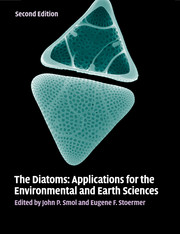Book contents
- Frontmatter
- Contents
- List of contributors
- Preface
- Part I Introduction
- Part II Diatoms as indicators of environmental change in flowing waters and lakes
- Part III Diatoms as indicators in Arctic, Antarctic, and alpine lacustrine environments
- Part IV Diatoms as indicators in marine and estuarine environments
- Part V Other applications
- 24 Diatoms of aerial habitats
- 25 Diatoms as indicators of environmental change in wetlands and peatlands
- 26 Tracking fish, seabirds, and wildlife population dynamics with diatoms and other limnological indicators
- 27 Diatoms and archeology
- 28 Diatoms in oil and gas exploration
- 29 Forensic science and diatoms
- 30 Toxic marine diatoms
- 31 Diatoms as markers of atmospheric transport
- 32 Diatoms as non-native species
- 33 Diatomite
- 34 Stable isotopes from diatom silica
- 35 Diatoms and nanotechnology: early history and imagined future as seen through patents
- Part VI Conclusions
- Glossary, acronyms, and abbreviations
- Index
- References
25 - Diatoms as indicators of environmental change in wetlands and peatlands
from Part V - Other applications
Published online by Cambridge University Press: 05 June 2012
- Frontmatter
- Contents
- List of contributors
- Preface
- Part I Introduction
- Part II Diatoms as indicators of environmental change in flowing waters and lakes
- Part III Diatoms as indicators in Arctic, Antarctic, and alpine lacustrine environments
- Part IV Diatoms as indicators in marine and estuarine environments
- Part V Other applications
- 24 Diatoms of aerial habitats
- 25 Diatoms as indicators of environmental change in wetlands and peatlands
- 26 Tracking fish, seabirds, and wildlife population dynamics with diatoms and other limnological indicators
- 27 Diatoms and archeology
- 28 Diatoms in oil and gas exploration
- 29 Forensic science and diatoms
- 30 Toxic marine diatoms
- 31 Diatoms as markers of atmospheric transport
- 32 Diatoms as non-native species
- 33 Diatomite
- 34 Stable isotopes from diatom silica
- 35 Diatoms and nanotechnology: early history and imagined future as seen through patents
- Part VI Conclusions
- Glossary, acronyms, and abbreviations
- Index
- References
Summary
Introduction
Wetlands comprise about 6% of the Earth's surface, but their ecological importance may be disproportionately higher (Batzer and Sharitz, 2006). Existing at the interface between terrestrial and aquatic landscapes, wetlands can support more species and greater productivity than adjacent communities because they are at the confluence of species pools and resources (Gopal et al., 2000; Wetzel, 2006). They are, therefore, important contributors to global biodiversity and their highly active biological communities modify nutrient and gas concentrations and soil-forming processes at a variety of scales. Organic wetlands (peatlands) store an estimated 450 gigatonnes of carbon (Gt C), equivalent to ∼20% of carbon in the terrestrial biosphere (Gorham, 1991; Maltby and Immirzi, 1993; Roulet, 2000) and almost equivalent to the entire global atmospheric carbon pool (Charman, 2002). The economic value of services that all wetland types provide to humans are reported to be higher than other ecosystems (Costanza et al., 1997) because they can be harvested for food, regulate availability and quality of fresh water, and protect neighboring landscapes from flooding.
Despite their importance, wetlands are being lost at an alarming rate. Almost half of the wetlands in the United States were drained or filled by 1970 (Tiner, 1984) and globally they are amongst the most threatened ecosystems on the planet. Threats come in the form of land loss and habitat degradation resulting from drainage for agricultural purposes, conversion for urban expansion, and flooding to create reservoirs for water storage or power generation.
- Type
- Chapter
- Information
- The DiatomsApplications for the Environmental and Earth Sciences, pp. 473 - 496Publisher: Cambridge University PressPrint publication year: 2010
References
- 23
- Cited by



